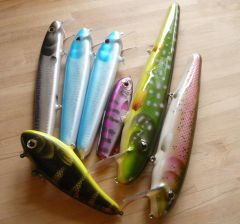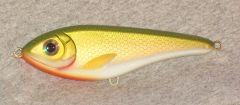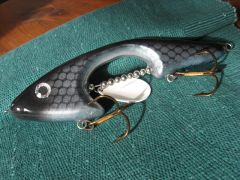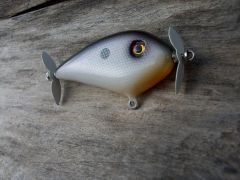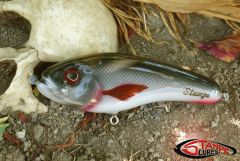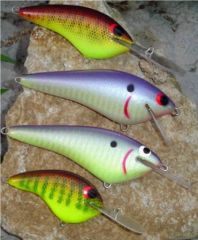-
Posts
55 -
Joined
-
Last visited
Content Type
Profiles
Articles
TU Classifieds
Glossary
Website Links
Forums
Gallery
Store
Everything posted by tauruck
-
Depends on how you work. If you've built a box you need to set up the original so that you will have your split line on as near a level plane as possible. You are actually building the mold half in the reverse of what you normally do. Pour the pop in from one corner of the box but do it very slowly and make shure the Slurry (pop/water) is slightly thinner than you normally make it. This will allow the box to fill slowly and hopefully you'll have less air entrapment (bubbles). You can knock the box against the working surface to help get rid of as much air as possible. Once the POP has cured drill the countersunk holes for the mold keys, do your release coating and continue with the second side. You may have a few pin holes in the first side you did but what I used to do was use the mold to produce a part. Then demold, trim off the bits that were created by the pin holes. Put the new part back in the good side and repour a new mold for the other half. You may lose the first part of the mold but there is a price to pay for using clay and for perfection.
-
I've only ever made a couple of POP molds even though mold making is part of my day job. I'm in composites but I spent a number of years doing RTV (Silicone) molds to produce statues for churches, bronze trophies and car parts. I might be wrong here and hopefully I'm not hijacking this thread but the problem seems to be setting up the part to be molded. If this has been covered before I apologise. Once I've built the box I use modelling clay to set up the "Original". It's soft enough to shape, cut with a hobby knife and everything else you need to do for your prep. Mold keys (locators) are easy to insert and it's fairly quick. It is also oil based and you won't need any form of release agent when you are ready to pour your first mold half. Maybe this will help, well I hope it does, Mikey. PS if the problem is keeping the plastic bait in the first POP mold half then give the the cavity a liberal coating of Vaseline (petroleum jelly), push the part back into place and wipe away the excess. I remember doing this in the past.
-
Way to go. That is what this is all about. There is no better feeling than catching a fish on your own lure. I did the same but I modified a smaller boat to enlarge it. I never got a bite off the thing. Bad luck I suppose. You doubled up on your setup though, sweeet.
-
-
-
-
Casting resin molds, how do i get a good shine?
tauruck replied to plasticpaul's topic in Soft Plastics
Paul, this is really easy. I'll go one step at a time. Retain one of your non shiny mould halves and get the plastic bait back in it if possible. It should be lying in the mould level with the split line. Now you apply your release agent (PVA) to the whole thing, cover the plastic bait and the resin well. When the release agent is completely dry put the box you originally built back around it or put the mould half in the box. I don't know how you did it the first time. Get the apropriate size paint brush, mix your gel coat/hardener and cover the entire mould half. When that is cured you can pour in the same polyester rein/filler mix you originally used. The next day you flip the mould over, split the halves and discard the old non shiny one. Clean the new half with water but try to leave the plastic in postion. A soft wet sponge works best to remove the PVA release. When the half is bone dry reapply fresh release agent and repeat the gel coat process again etc, etc. You'll have two new shiny moulds. -
Casting resin molds, how do i get a good shine?
tauruck replied to plasticpaul's topic in Soft Plastics
Straight resin normally suffers from exotherm if poured in a container/mould without filler with polyester being the worst resin for that. It warps, cracks and gives off noxious fumes. In most cases it will destroy the sample as well. Paul, just do your molding the same way as normal but use the gel coat. You obviously use a release agent when your first side has cured and repeat the process. -
Casting resin molds, how do i get a good shine?
tauruck replied to plasticpaul's topic in Soft Plastics
I only enlarged the pic after I posted the comment last night. It all became clear. You're obviously using a filler that you mix into the resin. These fillers create porosity and depending on the grain size this could be better or worse. Paint gel coat onto the s/p sample and when that goes Green (tacky to the touch) pour in your resin mix. You'll have a durable long lasting shiny surface. This will cure your problem for sure. As for the copyright I'm not sure but my guess is that if you tried to sell your product and pass it off as original you would most surely have a problem. Let me know how the molds turn out. Mikey. -
Thanks guys.
-
Casting resin molds, how do i get a good shine?
tauruck replied to plasticpaul's topic in Soft Plastics
Hey Paul, I work with resin everyday and it works like this. The mold will produce exactly what you made it off. If you want a good gloss on it you can use a burnishing compound available from the resin supplier. I use it for two reasons. A good release of the product and for a smooth part from the mould. If your mold is very rough at present you can start off with 1200 water paper and move on to the burnishing compound from there. Good luck and if you need any advice I'm on and off every 3 hours or so. Mikey. -
Thanks Dieter. I'll do that. I found Fibetts at a Fly fishing store but they want too much for too little, Lol. My wife says she knows where to get some similar material so I'll wait. This is all new to me and I found out today that Fly Fishing is expensive.
-
Thanks LaPala, I would like to go the bristle route. What do you think i should use?
-
I've seen so many swimbaits/jointed lures with very realistic looking dorsal fins and tails. I'd love to add some to the lures I'm trying to build. Anyone out there with some suggestions and advice?. Thanks in advance.
-
Hey David, good advice there. I used to cast my own plugs and seeing as I work with resins etc I understand your frustration with having to fill pinholes. It will drive you nuts. My solution was to first paint in a brushable gelcoat. White always served as a good base to paint from. You don't have to wait until it cures either, just bolt up the mould halves, wait 15-20 minutes and pour.
-
-
I'm still going to get into putting a clear coating on the batch of lures i've done. I'm hell bent on using automotive sprayable clear coat on my "creations" but my day job is composites so I work with epoxies and polyesters. Everything in life is a compromise and in a couple of weeks I'll probably be here screaming blue murder about why this and that won't work. The neat thing about this forum is that one knows what you're getting into way ahead of time. My epoxy supplier of 20 years can formulate the right product for the application and I'm going to ask for a tough, fast drying, cheap material that won't yellow with time. What are my chances???. Good thread.
-
-
-
I've just been looking at a lot of gator's work. Unreal. From the short time I've been on tackle forums I've got this thing where I see a lure and say to myself, Ahh, that's a fatfingers or a Rowhunter. In this case gator too has his own style/identity and I think his work is top quality. In my big five for sure. I love every one I've seen.
-
-
-
-





